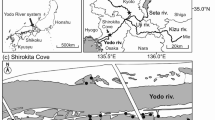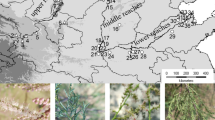Abstract
The effective control of invasive mammals, because of their potentially high dispersive capacity, demands an understanding of spatial patterns of gene flow leading to the designation of population units for systematic eradication. Nutria, or coypu (Myocastor coypus), are large, semi-aquatic rodents, originally exported from their native South America for the value of their fur, and are now considered pests on many continents due to overgrazing of wetlands. This study was aimed at assessing the potential for establishing eradication units for the control of nutria in a severely impacted region of the US, southern Louisiana, using nine microsatellite loci, and systematic sampling from each of eight major watershed basins. Unexpectedly high levels of genetic diversity were revealed in comparison to native populations both in terms of numbers of alleles and observed heterozygosities, suggesting that multiple source populations may have originally contributed to the establishment of the Louisiana fur trade, which have subsequently become intermingled. Genetic differentiation among watersheds was nearly undetectable, as evidenced by a very small, albeit significant overall F ST value of 0.0059. Interestingly, one of the Bayesian clustering algorithms used in this study identified 11 populations that may represent a fading remnant of the original source populations, although these clusters were not supported by a coherent pattern of geography. Unfortunately, these findings suggest that neither the establishment of locally manageable eradication units, nor the development of biological control agents known for their close association with a single source population will be effective in the control of Louisiana nutria.


Similar content being viewed by others
References
Abdelkrim J, Pascal M, Calmet C, Samadi S (2005) Importance of assessing population genetic structure before eradication of invasive species: examples from insular Norway Rat populations. Conserv Biol 19:1509–1518
Balloux F, Brunner H, Lugon-Moulin N, Hausser J, Goudet J (2000) Microsatellites can be misleading: an empirical and simulation study. Evolution 54:1414–1422
Bergman DL, Chandler MD, Locklear A (2002) The economic impact of invasive species to wildlife services’ cooperators. In: Clark L, Hone J, Shivik JA, Watkins RA, Vercauteren KC, Yoder JK (eds) Human conflicts with wildlife: economic considerations. Proceedings of the third NWRC special symposium. National Wildlife Research Center, Fort Collins, pp 169–178
Callahan CR, Henderson AP, Eackles MS, King TL (2005) Microsatellite DNA markers for the study of population structure and dynamics in nutria (Myocastor coypus). Mol Ecol Notes 5:124–126
Carter J, Leonard BP (2002) A review of the literature on the worldwide distribution, spread of, and efforts to eradicate the coypu (Myocastor coypus). Wildl Soc Bull 30:162–175
Carter J, Foote AL, Johnson-Randall LA (1999) Modeling the effects of nutria (Myocastor coypus) on wetland loss. Wetlands 19:209–219
Corander J, Waldmann P, Sillanpää MJ (2003) Bayesian analysis of genetic differentiation between populations. Genetics 163:367–374
Corander J, Waldmann P, Marttinen P, Sillanpää MJ (2004) BAPS 2: enhanced possibilities for the analysis of genetic population structure. Bioinformatics 20:2363–2369
Corander J, Marttinen P, Mantyniemi S (2006) Bayesian identification of stock mixtures from molecular marker data. Fish Bull 104:550–558
Cornuet JM, Luikart G (1996) Description and power analysis of two tests for detecting recent population bottlenecks from allele frequency data. Genetics 144:2001–2014
Courchamp F, Chapius JL, Pascal M (2003) Mammalian invaders on islands: impacts, control and control impact. Biol Rev 78:347–383
Di Rienzo A, Peterson AC, Garza JC, Valdes AM, Slatkin M, Freimer NB (1994) Mutational processes of simple-sequence repeat loci in human populations. Proc Nat Acad Sci USA 91:3166–3170
Estoup A, Guillemaud T (2010) Reconstructing routes of invasion using genetic data: why, how and so what? Mol Ecol 19:4113–4130
Evanno G, Regnaut S, Goudet J (2005) Detecting the number of clusters of individuals using the software STRUCTURE: a simulation study. Mol Ecol 14:2611–2620
Ford MA, Grace JB (1998) Effects of vertebrate herbivores on soil processes, plant biomass, litter accumulation and soil elevation changes in a coastal marsh. J Ecol 86:974–982
Gosling LM (1989) Extinction to order. New Sci 121:44–49
Goudet J (2002) FSTAT, version 2.9.3, a program to estimate and test gene diversities and fixation indices. http://www2.unil.ch/popgen/softwares/fstat.htm
Guichon ML, Borgnia M, Righi CF, Cassini GH, Cassini MH (2003) Social behavior and group formation in the coypu (Myocastor coypus) in the Argentinean pampas. J Mammal 84:254–262
Hampton JO, Spencer PBS, Alpers DL, Twigg LE, Woolnough AP, Doust J, Higgs T, Pluske J (2004) Molecular techniques, wildlife management and the importance of genetic population structure and dispersal: a case study with feral pigs. J Appl Ecol 41:735–743
Hedrick PW (1999) Perspective: highly variable loci and their interpretation in evolution and conservation. Evolution 53:313–318
Ibrahim KM, Nichols RA, Hewitt GM (1996) Spatial patterns of genetic variation generated by different forms of dispersal during range expansion. Heredity 77:282–291
Johnson-Randall LA, Foote AL (2005) Effects of managed impoundments and herbivory on wetland plant production and stand structure. Wetlands 25:38–50
Kinler N, Linscombe G, Hartley S (1998) A survey of nutria herbivory damage in coastal Louisiana in 1998. Fur and Refuge Division: Louisiana Department of Wildlife and Fisheries
Lawson Handley L-J, Estoup A, Evans DM, Thomas CE, Lombaert E, Facon B, Aebi A, Roy HE (2011) Ecological genetics of invasive alien species. Biocontrol 56:409–428
Lee CE (2002) Evolutionary genetics of invasive species. Trends Ecol Evol 17:386–391
Luikart G, Sherwin WB, Steele BM, Allendorf FW (1998) Usefulness of molecular markers for detecting population bottlenecks via monitoring genetic change. Mol Ecol 7:963–974
Mack RN, Simberloff D, Lonsdale WM, Evans H, Clout M, Bazzaz FA (2000) Biotic invasions: causes, epidemiology, global consequences, and control. Ecol Appl 10:689–710
Mantel NA (1967) The detection of disease clustering and a generalized regression approach. Cancer Res 27:209–220
Mullenbach R, Lagoda PJL, Welter C (1989) An efficient salt-chloroform extraction of DNA from blood and tissues. Trends Genet 5:391
Nei M, Maruyama T, Chakraborty R (1975) The bottleneck effect and genetic variability in populations. Evolution 29:1–10
Nolfo-Clements LE (2009) Nutria survivorship, movement patterns, and home ranges. Southeast Nat 8:399–410
Pritchard JK, Stephens M, Donnelly P (2000) Inference of population structure using multilocus genotype data. Genetics 155:945–959
Raymond M, Rousset F (1995) GENEPOP (version 1.2): population genetics software for exact tests and ecumenicism. J Hered 86:248–249
Rice WR (1989) Analyzing tables of statistical tests. Evolution 43:223–225
Robertson BC, Gemmell NJ (2004) Defining eradication units to control invasive pests. J Appl Ecol 41:1042–1048
Roderick GK, Navajas M (2003) Genes in new environments: genetics and evolution in biological control. Nat Rev Gen 4:889–899
Rohlf FJ (2000) NTSYSpc Ver. 2.1: numerical taxonomy and multivariate analysis system. Applied Biostatistics, Port Jefferson, New York
Schrey AW, Heist EJ (2003) Microsatellite analysis of population structure in the shortfin mako (Isurus oxyrinchus). Can J Fish Aquat Sci 60:670–675
Swarzenski CM (2003) Surface-water hydrology of the gulf intracoastal waterway in south-central Louisiana. U.S. Geological Survey Paper 1672. http://www.pubs.usgs.gov/pp/pp1672/pdf/pp1672.pdf. Accessed 15 Oct 2007
Taylor KL, Grace JB (1995) The effects of vertebrate herbivory on plant community structure in the coastal marshes of the Pearl River, Louisiana, USA. Wetlands 15:68–73
Taylor RH, Kaiser GW, Drever MC (2000) Eradication of Norway rats for recovery of seabird habitat on Langara Island, British Columbia. Restor Ecol 8:151–160
Towns DR, Broome KG (2003) From small Maria to massive Campbell: forty years of rat eradications from New Zealand islands. N Z J Zool 30:337–398
Túnez JI, Guichón ML, Centrón D, Henderson AP, Callahan C, Cassini MH (2009) Relatedness and social organization of coypus in the Argentinean pampas. Mol Ecol 18:147–155
Van Oosterhout C, Hutchinson WF, Wills DPM, Shipley P (2004) Micro-checker: software for identifying and correcting genotyping errors in microsatellite data. Mol Ecol Notes 4:535–538
Wright S (1931) Evolution in Mendelian populations. Genetics 16:97–159
Acknowledgments
The authors thank S. Merino for field assistance, J. Carter for assisting with the coordination of tissue sampling activities, B. Kubátová for technical assistance, and P. Leberg and D. Johnson for helpful comments on a previous version of this manuscript. Tissue samples and accompanying spatial information were obtained with the cooperation of Coastal Environments, Inc. Funding was provided by the National Invasive Species Program of the U.S. Geological Survey. The use of trade names is for descriptive purposes only and does not imply endorsement by the U.S. Government.
Author information
Authors and Affiliations
Corresponding author
Rights and permissions
About this article
Cite this article
Klima, K., Travis, S.E. Genetic population structure of invasive nutria (Myocastor coypus) in Louisiana, USA: is it sufficient for the development of eradication units?. Biol Invasions 14, 1909–1918 (2012). https://doi.org/10.1007/s10530-012-0201-5
Received:
Accepted:
Published:
Issue Date:
DOI: https://doi.org/10.1007/s10530-012-0201-5




